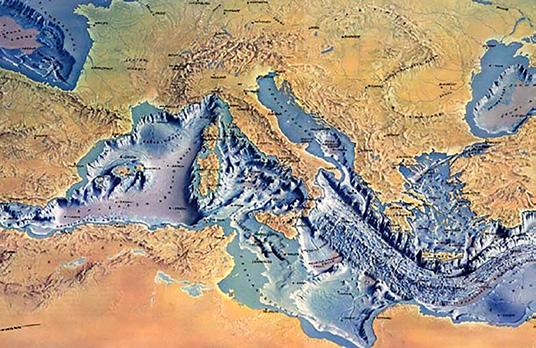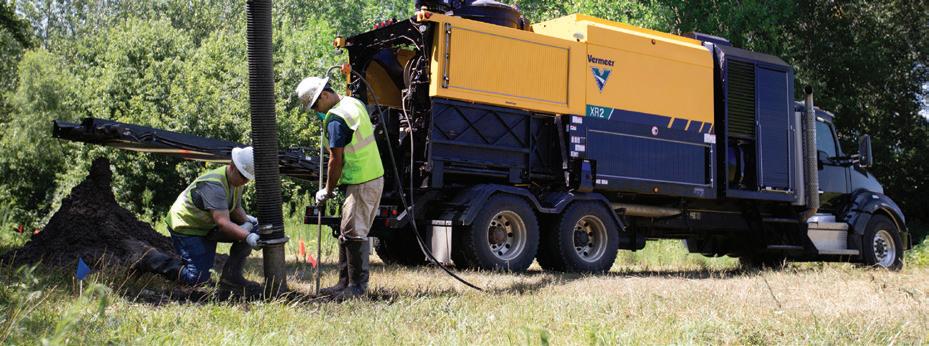
10 minute read
Innovation Committee
from IPLOCA Newsletter 83
by Pedemex BV
The Innovation Committee provides a forum, leadership and guidance to foster innovations and inform the IPLOCA membership about the current technologies and trends affecting the pipeline industry. It also collaborates with PRCI (Pipeline Research Council International) in the development of research studies that populate “The Road to Success” (RTS).
Novel Construction Fall Session The Novel Construction Spring session due to be held in Athens in April was postponed and will now be held in Spring 2021.
The upcoming Fall Novel Construction Meeting will take place at the Crowne Plaza Geneva from 21 to 22 October. All the details regarding this event will be announced at a later stage and will be available on our website: www.iploca.com/novelsession. Don’t forget to also include the Safety Leadership Training Session in your diary, being held at the same venue on 20 October.
The Novel Construction programme is expected to be very similar to the one confirmed for April and will include a morning open forum for member and non-member companies to present their newest developments within our industry. In the following pages a number of our speakers agreed to give you a taste of the content of their presentations, to entice you to come to listen to them live and exchange with other IPLOCA members.
In the afternoon, working groups will meet and discuss their contributions to the RTS app. New contributors to these groups are always welcome, so should you be interested in helping to keep the RTS up to date, please contact the appropriate group leader:
Current Construction Risks from a Contractor’s Perspective
Zahi Ghantous, Consolidated Contractors Group S.A.L (Offshore) (CCC)
The engineering and construction industry faces many risks and challenges that impact the business ability to successfully deliver projects on time and within budget. Failure to recognise and adequately manage risks whether corporate or project-related is detrimental to the overall effective management of any project.
Contracting risks range from global market conditions including commodity prices, investment opportunities, and fierce competition to commercial challenges such as stringent contractual terms and conditions, insufficient tendering periods, ambiguous contract requirements, cash flow matters and strenuous dispute resolution mechanisms. They comprise client risks including financial standing, experience, and SIMOPS management capabilities in addition to project-specific technical risks be they tight milestones, availability of pre-construction data, engagement of the right resources and split of responsibilities between stakeholders. EP partner and other synergy challenges, country risks such as currency fluctuations, political instability, ICV values, local laws, and reliability of local suppliers, and contractor own operations round up the main risks.
Whereas environmental risks cannot be overlooked either, the current business landscape has shed light on the unsettled geopolitical landscape, advance of national policies, and global economy events as key risks as well.
The COVID-19 pandemic has presented a sordid example on this type of risk which has repercussions on all project aspects involving travel and transportation restrictions, day-to-day operational requirements, country curfews, safety associated costs, and the like.
The pipeline sector – due to its nature of extended geographical spread – presents its own additional risks including the control of permitting and land entry agreements, handling multiple interfaces, execution of all types of crossings, varying weather conditions, additional safety hazards due to long open trenches for example, and security issues, to mention a few. CCC’s long track record of operation within different sectors of the industry and over diverse locations in the world has shaped its outlook on dealing with project risks, and consequently moulded its proactive approach to risk management whereby internal and external risks are identified from the early phases of execution; additionally, mitigation measures are continually revisited to ensure minimal disruption from threats and maximised utilisation of opportunities. Risk management is perceived as both a top priority and prerogative for corporate and project management, and advanced systems and tools are constantly evolving to empower the decision-making process and subsequently the success of project execution.
Earthquakes, Geohazards, and Real-time Remote Monitoring of Onshore and Offshore Gas Pipelines
Dr. Prodromos Psarropoulos, National Technical University of Athens, Greece
Many pipelines have been constructed worldwide, while many others are expected to be constructed in the near future. In parallel, our society demands increasing availability and reliability of energy supply, together with improved environmental standards.
Although most of the pipelines are onshore high-pressure gas pipelines, there is an evident increasing tendency for the construction of offshore gas pipelines. In some areas, such as S.E. Europe and the Mediterranean Sea, the earthquakes and the high seismicity may threaten the integrity of a pipeline since various potential earthquake-related geohazards and the consequent permanent displacements of the ground or the seabed may substantially distress the pipeline. Apart from the strong ground motion, the main potential earthquakerelated geohazards are: active-seismic-fault ruptures at the ground surface, soil-liquefaction phenomena, and/or earthquake-triggered landslides.
The simplistic provisions of seismic norms are rather incapable of sufficiently covering all issues of geohazard assessment and seismic design of pipeline projects (especially offshore). Therefore, the optimum (i.e. safe and in parallel cost-effective) design of a pipeline requires, apart from geoscientists familiar with qualitative geohazard assessment, engineers capable to perform the following: - Quantitative geohazard assessment (based on reliable data); - Realistic soil-structure interaction analyses; and - Design of various geotechnical and/or structural mitigation measures (if required).
Seabed morphology of the Mediterranean Sea, where great activeseismic-fault ruptures and submarine landslides frequently take place. (Permission from Atelier Berann, copyright Stern-Magazine)
Nevertheless, in many cases, despite the proper and complete design and construction, there are various reasons for the use of real-time remote monitoring schemes and early-response systems in order to reduce the seismic pipeline risk: - Human errors and negligence during the design, construction and/or operation phase cannot be excluded. Additionally, norms are not perfect and they are getting improved every 10 to 20 years. - All input data has a certain degree of uncertainty, and climate change makes this uncertainty even higher (e.g. heavy rainfalls increase the risk of landsliding under static and seismic conditions). - Seismic design relies on seismological studies based on probabilities and statistical interpretation of data.
- Some pipelines are located in remote isolated areas, with limited accessibility (e.g. mountains) or even zero accessibility (e.g. deep sea). - As modern seismic design allows certain damage levels (in the case of onshore pipelines), a relatively small aftershock may cause the collapse of a damaged pipeline if the structural damages of the main shock have not been identified and repaired quickly. - An early-response system (e.g. smart block valves that connect components) may decrease the loss of new or old facilities, and therefore the total risk.
The essence of asset monitoring is to identify threats at an early stage, so actions can be taken before those threats develop into major failures.
Based on that principle and backed by twenty years of experience in the industry, Omnisens has developed Lynx, an external integrity monitoring system that tackles the main threats affecting pipelines: incipient leaks, intrusions in the Right of Way (RoW) and various types of geohazards (landslides, subsidence, soil erosion or water infiltration).
Lynx is based on state-of-the-art distributed fiber optic technologies (DAS/DTS/DSS). By simply plugging an interrogator (Figure 1) to the Fiber Optic Cable (FOC), commonly deployed alongside pipelines for telecommunications purposes, we can turn the cable into a distributed acoustic/temperature/strain sensor with thousands of measurement points.

Figure 1 – Omnisens’ DITEST and DAS Interrogators
Figure 2 – Lynx Pipeline Monitoring Concept
complement DTS measurements, by analysing the acoustic signature generated by the leak. In the case of ThirdParty Intrusion (TPI), the system uses cutting-edge DAS technology to analyse various parameters of the acoustic signals generated by intruders, permitting identification of manual digging and heavy machinery activity at 5m and 10m around the pipeline respectively.

Based on those accurate measurements and thanks to sophisticated algorithms, Lynx can identify and classify early pipeline threats, locate them within meters and raise warnings or alarms in real-time via screen, email or SCADA, so operators can take immediate action (Figure 2). Deploying various instruments in a network configuration, and thanks to the system’s robustness, it is possible to continuously monitor thousands of kilometers of pipeline over multiple years without the need of recalibration. For Geohazard Monitoring (GM) applications, a DITEST interrogator is connected to a geotechnical FOC. The extreme sensitivity of the instrument enables Lynx to detect micro-deformations on the fiber produced by small ground movements, so various geohazard patterns can be identified and action taken before the pipeline is affected.

For Leak Detection (LDS), Lynx relies on Distributed Temperature Sensing (DTS) as the main source of information. The system measures small local temperature differences between the FOC and the surrounding soil, created by a leak (cold spot if gas; hot spot if oil). Distributed Acoustic Sensing (DAS) can also be applied to
Figure 3 - the Lynx Graphic User Interface (GUI) displaying a warning message over a pipeline asset represented on the Lynx GIS map.
The Tesmec Group is a leader in designing, manufacturing and selling systems, technologies and integrated solutions for the construction, maintenance and efficiency of infrastructures related to the transport and distribution of energy and data.
Recent developments in trenchers machinery have led to a revolutionary concept and the launch of the new EVO series on Tesmec models 975, 1150, 1475 and 1675. Due to improved flywheels gearboxes, new hydraulic components and the latest release of the TrenchTronic 5.0 for full digital control of the automatic digging function, EVO series machines combine lower chain-speed and higher chainpull in order to have higher break-out force of the teeth.
In case of abrasive rock, teeth consumption is the main operating cost; the only way to increase the teeth life and get a real cost saving is to reduce the digging chainspeed. EVO machines can trench hard and abrasive


rock with unmatched productivity and cost efficiency, combined with a significant fuel consumption reduction. Tesmec EVO Chainsaw machines are already involved in most of Tesmec’s pipeline (oil & gas) projects all around the world, resulting in substantial performance improvement even in the toughest conditions: hard solid rock and deep trenching. These models ensure minimal over-excavation with regular trench walls and floor. The excavated material is deposited in a continuous windrow alongside the trench.
All Tesmec trenchers can be equipped with a TrenchIntel 3D GPS system (to record data and position while trenching, realising a map built in real time) and with the new Remote Monitoring Control (Re.M), to monitor the machines’ parameters in order to avoid breakages and stoppages. Finally, the most recently released TrenchTronic 5.0 electronic control system makes trenchers easier to use and less dependent on operator skills.
XR2 – the Next Evolution in Vacuum Excavation
Dan Sharpe, Vermeer Pipeline, Vermeer Corporation, U.S.A.
The Vermeer XR2 vacuum excavator is not just a hydroexcavator, it’s an onsite recycling system.
This new concept in vacuum excavation allows contractors to carry 1500 gal (5678.1 L) of water to the job and can reduce hydro-excavator transport weights. It brings to the utility industry a new way to help solve disposal issues contractors face today. The XR2 also has an auto-leveling shaker deck that separates solids


from the liquid. Used water gets pumped into onboard holding tanks for later disposal, and the separated solid material can be offloaded to a truck or left onsite, depending on the material. By separating excavated solids from liquid on the jobsite, contractors can stay onsite longer, work efficiently and reduce disposal expenses. The remote control allows one-man operation of the boom, vac, conveyer, separation and dig pump. Whether you are utility potholing, stitch boring or slot trenching, the XR2 vacuum excavator will help you be Equipped To Do More ® .







